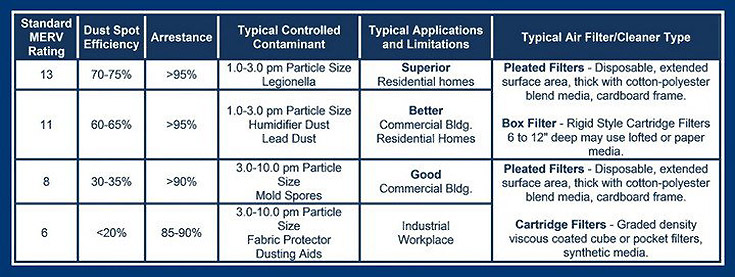Airtightness Effects
Most of the hazardous particulates enter the home from outdoors. The airtightness of a home is the most important factor to minimize airborne particles, known as PM2.5, in indoor air. PM2.5 means particles of less than 2.5 microns in diameter. Indoor air in very leaky buildings may have around 45% to 60% of the particle concentration as outdoor air. Airtight buildings’ indoor air may have less than 30% compared to outdoors. Of course if the windows are open, then indoor air particle count is the same as outdoors.
Effects of Air Filters
With natural circulation among rooms, efficient air filters can significantly reduce particle pollution in homes. The best places for filters are in forced-air HVAC systems or in balanced ventilation systems. Room air cleaners can also be effective particle removers, especially if home air is well mixed.
Air filters affect the airflow and energy consumption of forced air HVAC systems and balanced ventilation systems. The most common filter-rating method is the Minimum Efficiency Rating Value (MERV). A higher MERV rating means that the filter removes more particles and a higher fraction of smaller particles compared to low-MERV filters.
Before choosing the type of air filter, consider its MERV rating and a home’s need for particle removal. Particles are a health hazard in cities, near busy highways, near seasonal farming activities, and in regions with forest fires. Unless you have a high particle count in your home, a high MERV (MERV 16) filter probably isn’t necessary or desirable. Before considering a high-MERV filter, thoroughly air-seal your building because air sealing is a more effective way to control particle infiltration.
Air Filter Ratings
This MERV rating system divides particles into three size categories: 0.3–1, 1–3, and 3–10 μm. The two smallest categories are the most important for human health, as small respirable particles (PM2.5) can more easily deposit in the lungs compared to larger particles.
The MERV ratings of available HVAC filters range from MERV 3 to MERV 16, with higher ratings removing more particles at smaller sizes. A MERV 3 filter captures large particles — clothing fibers, pollen, and dust mites, but few smaller respirable particles. A MERV13 filter captures more than 70% of all three particle sizes, including bacteria and tobacco smoke. The minimum MERV rating to remove 50% of the respirable 1–3 μm particle-size range is MERV 10. If the HVAC blower operates continuously or for long cycles indoor air will pass repeatedly through the filter and become progressively cleaner with each pass.
 Effects of High-MERV Filters
Effects of High-MERV Filters
HVAC designers designed air handlers for use with low-MERV filters with a small pressure drop. Changing to higher-MERV filtration can cause the filter pressure drop to increase and the system airflow to decrease. High pressure may cause blowers to fail prematurely as they struggle to overcome system pressures beyond their design specification. For heating systems, the furnaces may overheat and cycle on their high limit switches. Airflow reductions in cooling systems risk coil icing and premature compressor failure. If a one-inch thick filter produces too much static pressure, you can modify the filter slot to allow a two-inch filter that has more surface area and lower static pressure.
Effects of Air Filters on Blower Motors
Permanent-split-capacitor motors (PSC) produce a measurable airflow in direct proportion to the system static pressure. Brushless-permanent-magnet (BPM), also called electronically commutated motors (ECM), move air at a constant volume and variable energy consumption.
The volumetric airflow rate of a blower is directly proportional to the energy consumed by the blower motor. Therefore, as the HVAC system’s static pressure goes up, a PSC motor uses less energy because it moves less air. On the other hand, an ECM motor uses more energy to maintain a constant airflow when static pressure increases.
Recommendations
The need for high-MERV filters depends on three factors.
- The type and concentration of airborne particles
- The size range of those particles
- The sensitivity of the occupants to those particles
If you live in a rural area with little air pollution or dust, a high MERV air filter isn’t necessary. However a high-MERV filter may provide important IAQ benefits if you live in a location with lots of smog, pollen, road dust, or seasonal forest fires.
Further Reading
Energy Implications of In-‐Line Filtration in California., 2013